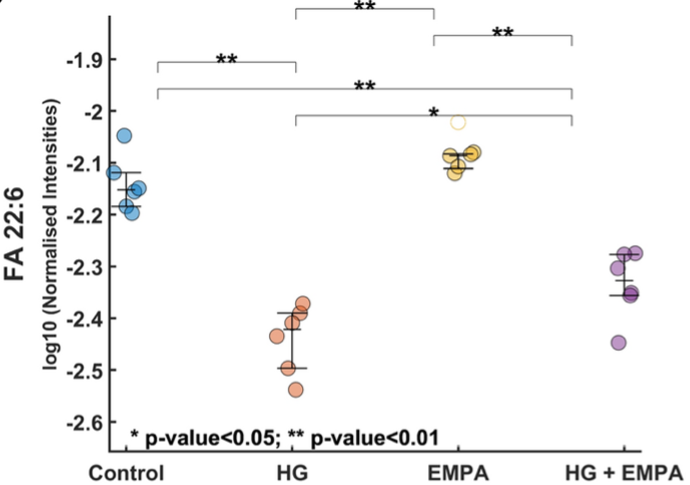Italian Study Shows Anti-Diabetic Drug Boosts NMN & Omega-3 Levels
The anti-diabetes drug empagliflozin elevates NMN and beneficial DHA omega-3 fat levels in human heart cells, suggesting it has numerous anti-aging effects.
Highlights:
- Empagliflozin raises NMN and DHA levels in normal human heart cells, suggesting potential anti-aging effects.
- NMN and DHA levels are also increased by empagliflozin in human heart cells exposed to high glucose, suggesting potential protection from diabetes-induced heart damage.
High blood glucose from diabetes wreaks havoc on the body, including the heart and, if severe enough, diabetes-induced heart damage can lead to heart failure. Additionally, diabetes leads to upticks in fat within heart cells that accelerate heart aging.
Now, researchers from the University of Campania in Italy report in the Journal of Translational Medicine that the anti-diabetes drug empagliflozin (EMPA) could protect the heart against not only diabetes but also aging. Namely, Scisciola and colleagues show that EMPA raises heart cell NMN levels and lowers heart cell fat levels, except for beneficial DHA fats.
“Rescuing NAD+ metabolism by NMN could be a viable strategy to elevate NAD+ levels, mitigate NAD+ imbalance, and improve cardiac dysfunction in diabetic hearts,” the authors explain.
Anti-Diabetes Drug Empagliflozin Elevates the Heart’s NMN and DHA
To model diabetes-induced cardiac damage, Scisciola and colleagues exposed human heart muscle cells (cardiomyocytes) to 6 times more glucose than normal. The high glucose levels significantly lowered NMN levels, but treatment with EMPA prevented this drop in NMN. Furthermore, EMPA increased NMN levels in normal heart cells, suggesting that EMPA could protect the heart from the ravages of aging.

(Scisciola et al., 2023 | J. Transl. Med.) Empagliflozin Raises Heart NMN. Compared to normal heart cells (Control), heart cells exposed to high glucose (HG: hyperglycemia) display a lower concentration of NMN. However, empagliflozin increases NMN levels in both normal (EMPA) and HG (HG + EMPA) heart cells.
The heart switches to metabolizing fats for energy instead of glucose in diabetes, leading to toxic effects that damage the heart, including increases in oxidative stress — a hallmark of aging. Scisciola and colleagues showed that while EMPA lowered toxic fats, it increased DHA omega-3 fats in both normal heart cells and heart cells exposed to high glucose.
“EMPA was able to increase only the level of FA 22:6 [DHA], which is an essential ω-3 polyunsaturated fatty acid that has been positively associated with improved cardiovascular cellular metabolism…,” the authors said about these results.

(Scisciola et al., 2023 | J. Transl. Med.) Empagliflozin Raises DHA Concentrations. Compared to normal heart cells (Control), heart cells exposed to high glucose (HG: hyperglycemia) display a lower concentration of DHA. However, empagliflozin increases DHA levels in both normal (EMPA) and HG (HG + EMPA) heart cells.
The Anti-Aging Effects of Empagliflozin
Empagliflozin is a sodium-glucose cotransporter-2 (SGLT2) inhibitor — the only class of glucose-lowering drugs that reduce the risk of cardiovascular death and heart failure. The authors add,
“As with other SGLT2 inhibitors, EMPA has shown beneficial cardiac effects also in non-diabetic hearts.”
This means that EMPA could have anti-aging effects on the heart and cardiovascular system. Indeed, a study showed that EMPA revitalizes the arteries of aged mice.
Furthermore, a recent human trial showed that NMN reduces blood pressure by countering low artery NAD+ levels. Since EMPA raises heart NMN levels, it could potentially raise artery NMN levels, leading to these anti-aging effects. However, future studies are necessary to determine if EMPA raises NMN and NAD+ levels in organs or tissues other than the heart.

